
Predicting the market evolution for the somewhat longer term, all the while having to invest in what seems to be the most profitable option today, is challenging endeavor. Nevertheless, that’s what satellite service providers have to accomplish even more than often than ever before.
This necessity may appear to be somewhat of a daunting task. After all, there is the relentless competition from fiber. However, such concerns shouldn’t keep you awake.
Ensuring satellite services remain relevant for the market is not as difficult as it might initially seem—to address this market doesn’t require a flawless crystal ball or loads of money. All that’s really needed is company agility and flexibility in the way the market is addressed and served.
In the more traditional satellite home territory of broadcast-related services, business opportunity abounds. Growth is ubiquitous, there’s more content to deliver, and all requires higher quality viewing for the consumer. Getting more Mbits out of your transponder and being agile in your ability to support changing IP based workflows are the key. The latter does translate into the need to support multiple services, which are now, more than ever, IP-based. For example, offering straightforward, one way, ASI-based contribution-only services might complete the trick for now, however, how long will this service keep the newsroom people happy?
In other areas, growth might be less obvious and the crowd of satellite service providers are all being gathered together in a smaller marketplace. Here, too, a revolution seems to be developing, now still rather quiet, but some might already hear the rumble of change.
The good old days where one could concentrate on a single type of service and continue to safeguard profitability are gone. In example, the decline of high speed IP trunking has definitely ensured that some service providers remain fully awake at night. Here, too, agility allows service providers to survive and even thrive. There’s simply too much action in the sky and on the ground that will keep satellite relevant for a long, long time, be that cellular backhauling into areas where terrestrial infrastructure cannot reach, or for Communication On The Move (COTM), where only satellite can maintain the connectivity.
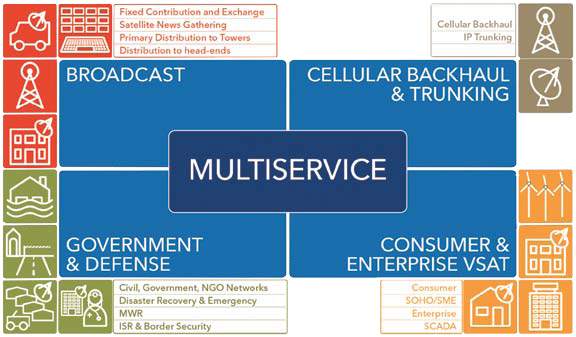
The Changing Media Rich World
Satellite operators and service providers are being required to respond quickly to changing market dynamics. At least, they are if they wish to diversify, offer improved quality of service and be more flexible on the delivery of Service Level Agreements (SLAs). Today, there is a need for higher service levels, both in terms of speed and volume, to deliver what the customer wants.
At the same time, applications are placing a strain on capacity by requiring more and more bandwidth. There has been well-documented growth in multimedia rich content, big data, HD video and a proliferation of channels. This is without even mentioning the introduction of 4K or everyone’s need to download more and to do it faster (whichever might be more relevant for your region of the world). In addition, the end user’s relationship with technology and the media is also changing and customers expect—even demand—an always-on connection which, in turn, leads to demands for higher service availability.
Low Hanging Fruits Are Harder To Reach
For a host of reasons, the level of profitability in the satellite services sector is under pressure. There is a squeeze going on—there are decreasing price levels on the one hand and higher bandwidth that results in higher satellite capacity costs on the other hand. Caught in-between these two forces is satellite services profitability.
But the forces get welcome backpressure—on the bandwidth supply side, it’s obvious and just to name one: We have all heard of Ka-band and how it is poised to mitigate a big part of the OPEX problem by reducing the cost of satellite capacity. At least, in some cases.
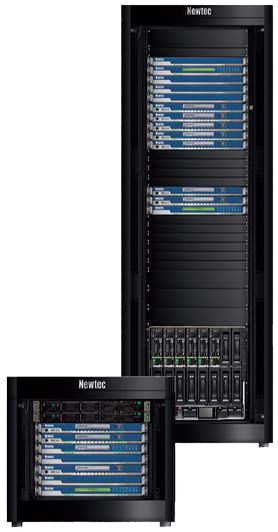
Figure 1: The Newtec Dialog® platform consists of hub(s) and terminals. The Newtec Dialog Hubs are modular and scalable and can be configured in different sizes to fit the needs of customers. This picture shows the HUB6501 1IF and the HUB6504 4IF Hub Modules.
It’s far from being a fit-for-all but where it fits, it fits really well. On the demand side, challenges remain, but they’re not necessarily business stoppers. Yes, customers expect lower prices, but nobody said those expectation can’t be met without jeopardizing profitability. You just need to make certain you differentiate among customers and manage their own particular set of expectations in an agile way. This defends against the churn monster, both in the consumer market and the hard-core B2B market alike.
The flexibility to adapt the nature of the services you offer to customers and to make sure they are delighted with your offerings, that they are being treated fairly, and giving them what they pay for (and are willing to pay for) is the route to ongoing success. In the all-ubiquitous IP world, that means fair usage policies are required together with highly diverse Quality of Service and shaping mechanisms.
No one has said such policies cannot be instituted—definitely not Newtec. Yes, profitability needs to be intelligently managed and, yes, there is a good possibility that once the ends have been met, someone might actually move those ends.
Once again, agility comes into play, with fair and efficient bandwidth allocation mechanisms embedded into your platform—in this way, the challenges can be met head on and surmounted.
Keeping Pace With Technology
When agility is required and surety seems lacking, the typical reaction is to revert back to technology. That works well, quite often. Unfortunately, this reliance on technology often means a highly tailored solution for the targeted problem. This is how service providers often end up with numerous, different platforms, each platform of limited fit, and tailored around a single technology. This results in proprietary technology roadmaps and various platform particularities in terms of operational support.
There’s good news, as well. While in first instance the need for agility might appear to come with particular technological solutions for particular markets, the ubiquity of IP renders those various needs more similar than one might think. In fact, it again all drills down to being efficient on the lowest layer—squeezing every possible bit out of every Hertz—while at the same time making certain there are numerous options available in terms of speed, throughput quality and higher layer networking functionality.
Once you can combine that agility with controlled availability, based on one single platform with its single and future proof roadmap, you’re basically “good to go.” You don’t need to spend lots of effort and money on different features that all require constant attention, with the concern that all are bound to be obsolete at different points in time in the future.
Some vertical markets will continue to have their own specific needs, however, for as long as your platform is agile from a connectivity point of view, there are always extensions you can add to support specific value added services, from embedded non-linear file transfer contribution in the broadcast world up to specific encryption mechanisms for government application.
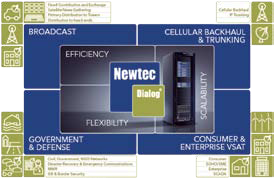
Figure 2: Newtec Dialog® opens up a multitude of possibilities for optimizing the usage of infrastructure and satellite capacity across different markets. The platform enables operators to adapt to any business scenario, including tailored services.
No Need To Be Afraid
The solution is the end of single purpose satellite infrastructure and the birth of truly, multi-service, technology platforms. Platforms that can address multiple markets and verticals, while simultaneously putting more customers, in the same transponder, are the goal.
Thanks to advanced QoS management and the simplified switching between SCPC, MF-TDMA and other more optimized return link capabilities, the goal is quite attainable. Together with the emergence of the new DVB standards, service providers will be able to differentiate and complement terrestrial services while adding more flexible and improved service offerings.
Differentiation becomes much more likely and plausible when satellite service providers are able to take rapid advantage of new market opportunities. The business case becomes far easier to make with a lower CAPEX, lower risk to cash flow and the use of a single investment for multiple verticals—your CFO will be less concerned about spending the money and will sleep better.
The CFO will not be the only one enjoying life just that little bit more, as running multiple platforms—as is often the case today—can be a true, operational nightmare.
The message is: Be ready for the era of multi-service infrastructure—this is no longer about making many different choices, but rather, making that single selection of an agile platform that ticks off all of the boxes.
Sleep tight. Others may need to stay vigilant and awake.
Meet Newtec Dialog®
The Platform That Embraces Change.
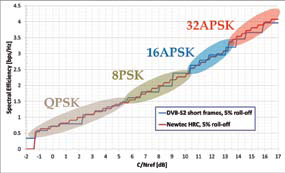
Figure 3: This line chart demonstrates the Newtec HighResCoding™ (HRC) coding and modulation (red line) compared with DVB-S2 Short frames (blue line) both using 5% roll-off. Newtec HRC combined with Newtec patented Mx-DMA™ bandwidth allocation provides S2-alike high efficiency with MF-TDMA-alike on-demand variable bandwidth allocation.
March of 2014 marks the launch of the Newtec Dialog® platform, a scalable and flexible multi-service platform that allows operators to build and adapt their infrastructure easily to accommodate their business and the satellite market as growth and change occur.
Newtec Dialog gives operators the power to offer a variety of new services on one platform, always with the knowledge they are using the most optimal modulation and bandwidth allocation possible.
Flexibility: Newtec Dialog allows you to adapt your infrastructure easily as your business changes.
Newtec Dialog is built to allow flexibility in the choice of technology and equipment, but also as to the types of services and applications available, ensuring a completely flexible focus for the businesses using the product. Newtec Dialog brings to service providers optimal efficiency and allows them to establish a business case for single or multiple markets using a single platform and Operations Support System / Business Support System (OSS/BSS).
Having a platform with these qualities opens up a multitude of possibilities for optimizing the usage of infrastructure and satellite capacity across different markets. For example, a provider with a history of servicing a majority of IP trunking clients can easily shift focus and start targeting broadcasting, backhauling, consumer and enterprise VSAT or government and defense markets quickly, all by using the same Newtec Dialog infrastructure. The platform enables operators to adapt to any business scenario and provides the capability of delivering tailored services.
Efficiency: Newtec Dialog enables the most optimal modulation and bandwidth allocation.
Newtec’s engineers have invented a new patented, return link technology that combines the best qualities of SCPC and MF-TDMA. Taking efficiency a step further, Mx-DMA™ including HighResCoding™ (HRC) is a revolutionary technology which gives MF-TDMA flexibility and on-demand variable bandwidth allocation at SCPC efficiencies. This typically results in doubling the transponder throughput using the same bandwidth, or alternatively reducing the required space segment capacity by 50 percent.
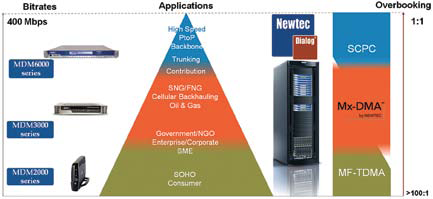
Figure 4: This graphic highlights the different markets that can be optimally addressed using the Newtec Dialog® platform, ranging from consumer broadband, corporate, cellular backhauling and up-to IP trunking, as well as broadcast market applications such as SNG/FNG and fixed contribution and exchange.
The new technology is ideally suited for low to medium overbooked types of applications having throughput rates up to 21Mbps: Enterprise/corporate networks, government/NGO networks, cellular backhauling and low to medium rate broadcast contribution and news gathering. The new technology also ensures low jitter and delay, perfect for applications such as voice and streaming video.
The platform also supports SCPC DVB-S2, and Newtec S2 extensions return link for applications which demand high bandwidth and MF-TDMA 4CPM technology for highly overbooked services, such as Internet access for consumers, SME/B2B and SCADA.
The MDM3000 series of Newtec modems, which run on the Newtec Dialog platform, support all three return link technologies, which enables operators to optimize the service delivered to individual end-customers via a simple configuration in the NMS and that, at any time, and with minimal impact. The Dialog System is software upgradeable to support the new DVB-S2X in the return link, as well.
All return link technologies are combined with Newtec’s core technology FlexACM®, a highly efficient Adaptive Coding and Modulation (ACM) algorithm using Newtec patent pending technology.
With these technologies, Dialog is able to provide the most optimal modulation and bandwidth allocation at any time, for any application and any satellite, while guaranteeing the highest efficiency.
Scalability: Newtec Dialog offers you a platform to build your business to the size you need it.
The platform is designed to be used for every type of networking: from the smallest (i.e., five remotes) up to the largest (having hundreds of thousands remotes), from single coverage to multi-spot High Throughput Satellite (HTS) networks. Additionally, operators can invest further as their business grows. The HUB scalability and flexibility enables low, up-front CAPEX requirements.
The platform will use Newtec’s proven modems, including the MDM2000 and MDM3000 series. The modems have many off-the-shelf features embedded, such as acceleration and compression, encryption, multi-language web GUI and IPv4/IPv6. The modems also have the advantage of being easy to install using Newtec’s Point&Play®
self-installation system.
Newtec Dialog embraces change by offering an easy to use platform which allows operators to build their business to the size they need, while also allowing them to easily adapt their infrastructure as their businesses or the market changes.
In today’s fast changing satellite market, where technology rapidly evolves, Newtec Dialog will provide the peace of mind that any market can be addressed, at any scale, without complexity. This enables companies to drive their profitability by being agile, all the while offering the best quality of service and experience for their customers.
For further information, please access any of the following URLs
www.newtec.eu
Twitter.com/Newtec_Satcom — Linkedin.com/company/newtec
Youtube.com/NewtecSatcom — Slideshare.net/newtec_satcom

